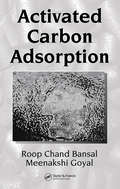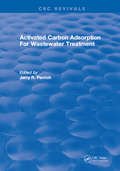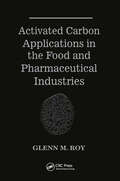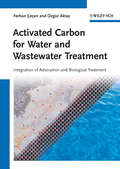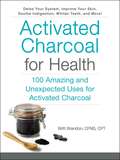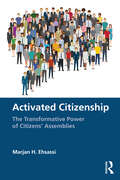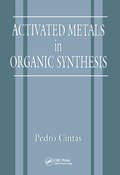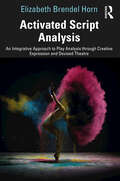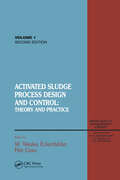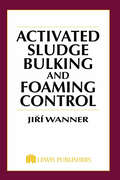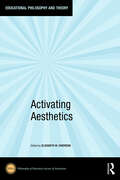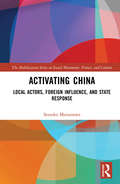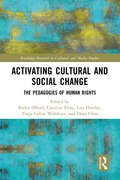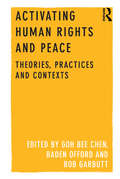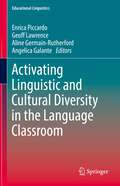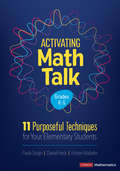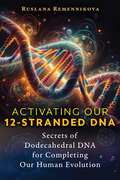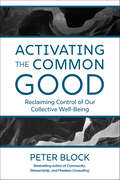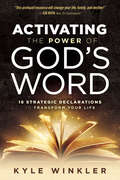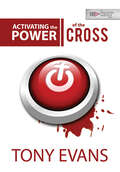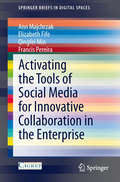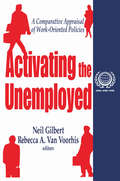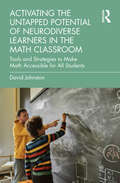- Table View
- List View
Activated Carbon Adsorption
by Roop Chand Bansal Meenakshi GoyalHigh surface area, a microporous structure, and a high degree of surface reactivity make activated carbons versatile adsorbents, particularly effective in the adsorption of organic and inorganic pollutants from aqueous solutions. Activated Carbon Adsorption introduces the parameters and mechanisms involved in the activated carbon adsorption
Activated Carbon Adsorption For Wastewater Treatment
by Jerry. R. PerrichThis volume is a guide to the state of the art of activated carbon adsorption technology as applied to wastewater treatment. This book surveys this body of knowledge and is a detailed description of current technology.
Activated Carbon Applications in the Food and Pharmaceutical Industries
by Glenn M. RoyActivated carbon has proven itself as a superior adsorbent for hundreds of food, beverage, agricultural, and pharmaceutical processing applications. This book provides a comprehensive, scientific survey of activated carbon applications based on existing literature. A valuable resource for all technical personnel involved in the processes discussed.
Activated Carbon for Water and Wastewater Treatment: Integration of Adsorption and Biological Treatment
by Ferhan Cecen Özgür AktasThis monograph provides comprehensive coverage of technologies which integrate adsorption and biological processes in water and wastewater treatment. The authors provide both an introduction to the topic as well as a detailed discussion of theoretical and practical considerations. After a review of the basics involved in the chemistry, biology and technology of integrated adsorption and biological removal, they discuss the setup of pilot- and full-scale treatment facilities, covering powdered as well as granular activated carbon. They elucidate the factors that influence the successful operation of integrated systems. Their discussion on integrated systems expands from the effects of environmental to the removal of various pollutants, to regeneration of activated carbon, and to the analysis of such systems in mathematical terms. The authors conclude with a look at future needs for research and develoment. A truly valuable resource for environmental engineers, environmental and water chemists, as well as professionals working in water and wastewater treatment.
Activated Charcoal for Health: 100 Amazing and Unexpected Uses for Activated Charcoal
by Britt BrandonFor fans of natural remedies and the popular For Health series, a hands-on guide to the transformative healing, wellness, and beauty benefits of activated charcoal.Activated charcoal—a medicinal-grade powder most commonly made from coconut shell—has endless health and beauty benefits. In Activated Charcoal for Health, you’ll discover everything this all-natural powder can do—from combating chronic diseases to providing relief for common ailments. With its anti-fungal, anti-viral, and antibacterial properties, activated charcoal can be used for many things such as clearing up acne, disinfecting wounds, helping to prevent hangovers, treating bad breath and body odor, and even providing a digestive cleanse. It’s even great for whitening teeth, balancing oily skin, exfoliating, and cleansing hair. With this handy guide, you’ll learn how to incorporate activated charcoal into your daily life and reap its benefits—without the use of dangerous chemicals or costly procedures.
Activated Citizenship: The Transformative Power of Citizens' Assemblies
by Marjan H. EhsassiTo counter pervasive levels of citizen disengagement from political institutions, this book examines democratic innovations that meaningfully engage with citizens to address some of the deficits of Western representative democracies.Citizens’ assemblies provide one such innovation, offering opportunities for more consistent participation between elections, more meaningful input in government decision making, and more impactful platforms for participation. This cutting-edge book introduces a new definition for an Activated Citizen, along with a methodology to measure civic and political engagement. Relying on a mixed-methods approach and field research conducted in Paris, Brussels, Ottawa, and Petaluma (California), as well as participant observations, over 180 surveys, 61 in-depth interviews and storytelling, the book provides case studies and in-depth analysis of hotbutton topics including climate change, unhoused populations, democratic expression, assisted suicide and euthanasia. Each chapter weaves quantitative results with rich qualitative testimonies from participants, government representatives, and observers. Based on empirical evidence, the book explores the ways in which government-led citizens’ assemblies can promote a more Activated Citizen. To fully realize the transformative potential of deliberative platforms, a final chapter offers a blueprint for impact, outlining concrete measures along with recommendations for the design and implementation of future government-initiated deliberative platforms.Activated Citizenship urges the deliberative community to be more discerning and intentional to more positively impact participants’ knowledge, sense of community, enthusiasm, political engagement, as well as their sense of meaningful voice. It will be required reading for all students and scholars interested in political participation and democratic innovation.
Activated Metals in Organic Synthesis (New Directions In Organic And Biological Chemistry Ser.)
by P. CintasActivated Metals in Organic Synthesis discusses fundamental principles of the generation of activated, highly reactive metals, and their applications in organic synthesis. Following an introductory chapter on basic forms of metals the chapters in Part 1 are devoted to common strategies utilized for the preparation of active metals. These strategies include vaporization and subsequent co-condensation of metal atoms, in addition to depassivating methods employed commonly in laboratory syntheses. Chapters in Part 2 discuss relevant organic transformations in which metal activation plays a crucial role. Specific topics covered include metal-induced reductive methods; pinacolic, Reformatsky-, and Barbier-type reactions; McMurry ketone-olefin coupling; and the Bernet-Vasella reaction. Each chapter is followed by literature citations ranging from specific references to significant reviews. Many structural formulas are provided, making it easy to follow each synthesis. The book will be an important reference for students, organic chemists, and researchers in all areas of organometallic chemistry.
Activated Script Analysis: An Integrative Approach to Play Analysis through Creative Expression and Devised Theatre
by Elizabeth Brendel HornActivated Script Analysis engages theatre students in traditional formative script analysis through a fusion of devised theatre and various modes of creative expression, dispelling the notion of script analysis as an isolated pen-to-paper task and reimagining it as a captivating and collaborative process. This book uses diverse, contemporary plays to model the script analysis process for each of four Theatrical Elements: Given Circumstances; Character; Setting; and Structure. By considering each of these elements, readers can uncover patterns and themes within a dramatic text. Woven throughout the study of each theatrical element are "Connections": Personal Connections, which encourage readers to explore a theatrical element within their own lives, as though their lives were a script; Play Connections, which make abstract ideas presented in script analysis concrete through theatre-based play; Professional Connections, which examine how a theatre professional might analyze a script within their own work; and Performative Connections, which provide the opportunity for students to explore a theatrical element through performance using devised theatre strategies. At the end of each chapter, readers are given the opportunity to analyze a text through the lens of a Theatrical Element and to express their findings through a variety of digital, written, visual, and performance-based modes of expression. Activated Script Analysis is designed for undergraduate theatre students and educators, to be used as the primary text in Script Analysis coursework or as a supplemental text in Acting or Directing courses. The book includes access to downloadable templates and example videos, available at www.routledge.com/9781032125398.
Activated Sludge: Process Design and Control, Second Edition
by W. Wesley Eckenfelder Petr GrauContents: Process Theory Kinetics and Sludge Quality Control: Activated Sludge Process - Process Theory - Activated Sludge Separation Problems - References Activated Sludge Treatment of Municipal Wastewater U.S.A. Practice: General Approach - Clarifier Design - Aeration Tank (Reactor) Design - Appurtenance Design - Configurations - ReferencesEurope
Activated Sludge: Bulking and Foaming Control
by Jiri WannerThe result of over 25 years of research, this book is a concise guide to the microbiological and technical aspects of bulking and foaming control. It stresses practical control measures based on kinetic and metabolic selection theories and supported by case histories. Topics include: biochemical processes in wastewater treatment, evaluation of separation problems, settling and foaming principles, bulking and foaming control methods, and system design. More than 100 tables and figures illustrate complex processes, and over 500 references provide a detailed compendium of available resources. Cross-references provide background of a problem, its connection to similar problems, and their solutions.
Activating Aesthetics (ISSN)
by Elizabeth M. GriersonActivating Aesthetics addresses questions of aesthetics in various fields of education, with the aim of investigating a way of revealing how aesthetics may activate an engaged, responsive and poetic pedagogy. The writers in this collection enliven different ways of thinking about aesthetics, educating through aesthetics and questioning aesthetics. They approach aesthetics through the lenses of art practice and art history, painting and literature, film and popular culture, the built environment and pedagogy, music making and reception, and feminist subjectivity and philosophy. Beyond instrumentalism, each chapter approaches questions of aesthetics by dismantling subject–object separations of analytical aesthetics and opening the potential of aesthetics to work as an activating force in education. The premise is that education, driven by means–end instrumentalism, may be activated another way via aesthetic encounters premised in difference. To build this argument, the authors engage works of Adorno, Benjamin, Bourdieu, Deleuze, Guattari, Heidegger, Hölderlin, Hokusai, Irigaray, Nietzsche, Sterne and Stiegler. The juxtaposition of these diverse theorists, philosophers, artists and writers makes for a rich tapestry of different perspectives on processes of learning, knowing and being. Aesthetics in activation discloses new ways of thinking about poetic and engaged pedagogy. Through these different perspectives, the whole collection works towards an educational philosophy of aesthetics. The chapters in this book were originally published as articles in the Educational Philosophy and Theory journal.
Activating China: Local Actors, Foreign Influence, and State Response (The Mobilization Series on Social Movements, Protest, and Culture)
by Setsuko MatsuzawaThis book examines the effects of the transnational social and environmental advocacy of foreign NGOs in China. Based on three case studies, including China’s first participatory development project, its first successful case of transnational anti-dam activism, and its first national park project, the book challenges our typical understanding that global forces shape local outcomes. Drawing on ethnographic fieldwork in China and archival work in the United States, Matsuzawa sheds light on the entrepreneurial behaviors of Chinese activists, researchers, and government officials. She shows that global projects are often substantially transformed by local actors, despite the original intentions of their foreign collaborators and even China’s central government. Thus, it is argued that foreign NGOs are not as hegemonic or culturally imperialistic as is commonly viewed. Matsuzawa reveals that their goals may change profoundly as a result of their engagements with local actors on the ground. She offers a new theory of transnational advocacy together with an account of the Chinese party-state’s rising concerns over the influence of foreign NGOs. Activating China will be of interest to sociologists and political scientists working in the fields of social movement studies and activism in China.
Activating Cultural and Social Change: The Pedagogies of Human Rights (Routledge Research in Cultural and Media Studies)
by Baden OffordIn this thought-provoking book, a diverse range of educators, activists, academics, and community advocates provide theoretical and practical ways of activating our knowledge and understanding of how to build a human rights culture. Addressing approaches and applications to human rights within current socio-cultural, political, socio-legal, environmental, educational, and global contexts, these chapters explore tensions, contradictions, and complexities within human rights education. The book establishes cultural and educational practices as intrinsically linked to human rights consciousness and social justice, showing how signature pedagogies used by human rights practitioners can be intellectual, creative, or a combination of both. Across three sections, the book discusses ways of bringing about holistic, relevant, and compelling approaches for challenging and understanding structures of power, which have become a global system, while also suggesting a move from abstract human rights principles, declarations, and instruments to meaningful changes that do not dehumanise and distance us from intrinsic and extrinsic oppressions, denial of identity and community, and other forms of human rights abuse. Offering new critical cultural studies approaches on how a human rights consciousness arises and is practised, this book will be of great interest to scholars and students of cultural studies, education studies, critical sociology, human rights education, and human rights studies.
Activating Human Rights and Peace: Theories, Practices and Contexts
by GOH Bee Chen Baden OffordHuman rights and peace issues and concerns have come about at a critical time. The world has recently witnessed a plethora of turning points that speak of the hopes and vulnerabilities which are inherent in being human and demonstrate that change in the service of human rights and peace is possible. At the same time, however, other events indicate that wherever there is life, there is vulnerability in a world characterized by instability and endemic human suffering. On top of all this, the collapse of the global financial system and the serious, rapid destruction of the environment have brought the world to a precarious state of vulnerability. Activating human rights and peace is, therefore, a project that is always in progress, and is never finally achieved. This enlightening collection of well thought through cases is aimed at academics and students of human rights, political science, law and justice, peace and conflict studies and sociology.
Activating Linguistic and Cultural Diversity in the Language Classroom (Educational Linguistics #55)
by Enrica Piccardo Geoff Lawrence Aline Germain-Rutherford Angelica GalanteThis book challenges the reader to rethink and reimagine what diversity in language education means in transnational societies. Bringing together researchers and practitioners who contributed to the international LINguistic and Cultural DIversity REinvented (LINCDIRE) project, the book examines four pillars of innovation in language education: the Action-oriented approach, Plurilingualism, Indigenous epistemologies and Technology enhanced learning. The book critically discusses plurilingual pedagogical approaches that draw on learners' linguistic and cultural repertoires to encourage and support the dynamic use of languages in curricular innovation. It is a fundamental resource for language teachers, curriculum designers and educational researchers interested in understanding current thinking on the relevance and benefit of a plurilingual paradigm shift for language education in today's societies. More specifically, this book: Examines the development of plurilingualism and the potential of real-life oriented teaching and learning. Explores the concept of plurilingual and pluricultural competence. Focuses on collaboration and reflection from a humanistic tradition. Explores educational technology and explains the limitations and challenges of adopting ready-made tools. Highlights the iterative, design-based research process that informed the development of LINCDIRE’s pedagogical framework and action-oriented scenarios. Introduces practical examples of action-oriented tasks and scenarios, and illustrates the online tool (LITE) in terms of its current functionalities and design. Describes the implementation challenges and opportunities of plurilingual action-oriented tasks and discusses the results of implementation. Finally, the book examines future pedagogical innovation and research directions in order to help readers reflect on the implications of achieving sustainable change in language education.This exciting collection addresses an important question in language education: How can plurilingualism and cultural diversity be harnessed to promote sustainable innovation in language learning and teaching? Readers will find contributions from the diverse authors timely, compelling, and engaging.— Dr. Bonny Norton, FRSC, University Killam Professor, UBC Dept. of Language & Literacy Education, CanadaEmbracing a design-based research framework, this book offers learners and teachers powerful validation and a rich, relatable and inspiring action-oriented approach to holistic, dynamic, mediated, embodied, true-to-life, plurilingual language teaching and learning.— Dr. Elka Todeva, Professor of Applied Linguistics, MATESOL Program / Advanced Seminar in Plurilingual Pedagogy, SIT Graduate Institute, Washington, D.C.Anyone seeking innovation in Language Education will find in this volume a treasure trove of theoretical, empirical and methodological insights to answer the questions that arose among the 25 co-authors’ discussions to rethink language use, language learning, and language teaching.— Dr. Mercedes Bernaus, Emeritus Professor, Universitat Autònoma de Barcelona, SpainThis thought-provoking and timely book argues convincingly for the need to reconceptualize innovation in language education in an increasingly diverse world. —Dr. Regine Hampel, Associate Dean (Research Excellence), Faculty of Wellbeing, Education and Language Studies, The Open University, UK
Activating Math Talk: 11 Purposeful Techniques for Your Elementary Students (Corwin Mathematics Series)
by Paola Sztajn Daniel Heck Kristen MalzahnAchieve High-Quality Mathematics Discourse With Purposeful Talk Techniques Engaging students in high quality discourse is important for their conceptual learning, but successfully promoting such discourse in elementary classrooms—with attention to the needs of every learner—can be a challenge. Based on research, Activating Math Talk tackles this challenge by bringing 11 practical, math-specific, productive discourse techniques to the classroom. You will be guided through each technique with · Classroom examples spanning grades K–5 · Reflection moments to help you relate to your own instruction · Classroom vignettes that illustrate the techniques in action · Group discussion questions for engaging with colleagues
Activating Math Talk: 11 Purposeful Techniques for Your Elementary Students (Corwin Mathematics Series)
by Paola Sztajn Daniel Heck Kristen MalzahnAchieve High-Quality Mathematics Discourse With Purposeful Talk Techniques Engaging students in high quality discourse is important for their conceptual learning, but successfully promoting such discourse in elementary classrooms—with attention to the needs of every learner—can be a challenge. Based on research, Activating Math Talk tackles this challenge by bringing 11 practical, math-specific, productive discourse techniques to the classroom. You will be guided through each technique with · Classroom examples spanning grades K–5 · Reflection moments to help you relate to your own instruction · Classroom vignettes that illustrate the techniques in action · Group discussion questions for engaging with colleagues
Activating Our 12-Stranded DNA: Secrets of Dodecahedral DNA for Completing Our Human Evolution
by Ruslana Remennikova• Reveals how vibration and intention can transform DNA from the standard double helix to its 12-stranded form, unlocking your physical and spiritual potential• Explores the intimate relationship of water and DNA and how they both react to sound and consciousness• Shares ten specific frequencies that resonate with DNA as well as techniques and meditations to activate your 12-stranded DNA for emotional and physical healing, resolution of ancestral trauma, and conscious evolutionIn this vibrant guidebook, sound healer and former corporate scientist Ruslana Remennikova reveals how, through vibration and intention, you can shapeshift DNA from the standard double helix to its 12-stranded, dodecahedral form—thereby unlocking your spiritual potential and opening the way for deep healing of the past, the present, and the future of your deeper self.Examining the alchemy behind the 12 strands of our DNA, the author looks at the intimate relationship between water and DNA, showing how both respond to vibrational frequencies as well as to consciousness. She also shows how unresolved grief creates oxidative stress in the body that targets our cellular mitochondrial DNA, leading to psychological and physical illnesses. She explains how sound can transform our DNA into an evolutionary activator and healing mechanism, helping the body to detox, resolve grief and trauma, and address stress-induced imbalances at the cellular level.Sharing techniques and meditations that help you activate all 12 strands of your DNA, the author reveals the revolutionary healing powers inherent in each of us for personal healing, spiritual transformation, and the completion of our human evolution.
Activating the Common Good: Reclaiming Control of Our Collective Well-Being
by Peter BlockA powerful, inspiring, and achievable vision of a society based on cooperation and community instead of competition and commodification. This book counters the dominant and destructive story that we are polarized, violent, selfish, and destined to consume everything in sight. That is not who we are. The challenge, Peter Block says, is that we are suffering under an economic theology that is based on scarcity, self-interest, competition, and infinite growth. We're told we can purchase and outsource all that matters. Block calls this the business perspective narrative. It dominates not only the economy but also architecture, faith communities, journalism, arts, neighborhoods, and much more. Block offers an antidote: the common good narrative. It embodies the belief that we are basically communal and cooperative. And that we have the capacity to communally produce what we care most about: raising a child, safety, livelihood, health, and a clean and sustainable environment. This book describes how shifts to the common good perspective could transform many areas, fostering journalism that reports on what works, architecture that designs habitable spaces creating connection, faith collectives that build community, a market that is restrained and local, and leadership and activism that build social capital by creating trust among citizens. With these shifts, we would fundamentally change the world we live in for the better.
Activating the Power of God's Word: 16 Strategic Declarations to Transform Your Life
by Kyle WinklerPowerfully speak God's Word, renew your mind, and experience transformation in your life. There&’s a singular power woven into the very foundation of creation. When triggered, it has the authority to calm chaos, restore life, and overcome obstacles. The secret? God&’s spoken Word.Activating the Power of God&’s Word gives in-depth teaching into speaking scripture and leads readers in sixteen strategic declarations that put its power to work for every area of life.
Activating the Power of the Cross
by Tony EvansYou've got to activate the power to experience the power.What would happen if our phones and computers ran out of power and couldn't be recharged? They would still have everything necessary to provide us with what we use them for, but without power they&’d be useless. There is something more powerful than the technology we use each day. And it has an even greater capacity to positively impact and enrich our lives in every way. Yet it is an untapped, frequently inactivated resource. That something is the cross.In this book, Dr. Tony Evans will help you understand how to activate the power of the cross, gaining access to all of the benefits, blessings, and power contained within it and through it, so that you can live the empowered and victorious life God intended.
Activating the Power of the Cross
by Tony EvansYou've got to activate the power to experience the power.What would happen if our phones and computers ran out of power and couldn't be recharged? They would still have everything necessary to provide us with what we use them for, but without power they&’d be useless. There is something more powerful than the technology we use each day. And it has an even greater capacity to positively impact and enrich our lives in every way. Yet it is an untapped, frequently inactivated resource. That something is the cross.In this book, Dr. Tony Evans will help you understand how to activate the power of the cross, gaining access to all of the benefits, blessings, and power contained within it and through it, so that you can live the empowered and victorious life God intended.
Activating the Tools of Social Media for Innovative Collaboration in the Enterprise (SpringerBriefs in Digital Spaces)
by Ann Majchrzak Elizabeth Fife Qingfei Min Francis PereiraThe use of social media tools in the enterprise is expanding rapidly and yet, firms are still unclear about the overall value of this activity and how best to facilitate useful outcomes. The focus of this book is, from a managerial standpoint, the control of information, the extent to which such tools can enhance employee satisfaction and how best to use social media tools to attain specific outcomes including innovative collaboration. As companies turn to IT solutions as substitutes for face-to-face engagements, an understanding of the social dynamics - how employees can best communicate, find and use information and generate motivation through computer-mediated activities is fundamental. Lingering questions relate to the strategic use of these tools; many large companies are using Facebook-like applications due to employee demand, but are not studying outcomes comprehensively or managing processes to create desired outcomes. This book fills this knowledge gap through examining the process and results of a controlled study in two companies, one in the US and the other in China. In each company "wiki challenges" were introduced to employees who were provided guidelines to produce goal-oriented outcomes. The book examine the results in each case and suggest guidelines for firms to achieve "wiki-readiness" to support innovation and co-creation.
Activating the Unemployed: A Comparative Appraisal of Work-Oriented Policies
by Neil Gilbert Rebecca A. Van VoorhisThe last decade has witnessed a conspicuous alteration in policies protecting unemployed people in modern welfare states. Social policies are increasingly designed to encourage economic independence. Policy makers have introduced a wide range of reforms linking disability, unemployment, and welfare programs cash benefits to work-oriented measures.Welfare policies are being framed by a new emphasis on recipients' obligations, emphasizing that the receipt of benefits creates a responsibility to take action towards becoming self-reliant. The objective is to minimize the duration of dependence or improve the well-being of family or community. Activating the Unemployed addresses this growing interest in work-oriented measures. This represents a shift in the dominant discourse on social welfare from focus on the citizen's rights to social benefits to emphasis on their responsibilities to work and lead an active life. In this volume, a distinguished array of international contributors provide cross-cultural perspectives to analyze recent diverse policy initiatives to activate the unemployed in nine countries-Britain, France, Italy, the Netherlands, New Zealand, Norway, Sweden, Switzerland, and the United States. Each provides a systematic account of the background, design, implementation, and results of employment-oriented measures. Collectively they permit comparison of organized responses to common problems in the areas of public assistance (welfare), unemployment, and disability, among others. Further chapters seek to broaden perspectives on policy options, the issues raised, and lessons learned in the course of activating the unemployed. This thorough and insightful account addresses significant contemporary issues and concerns about welfare, social security, and unemployment. It will aid policy makers, professionals, and scholars in assessing current trends in welfare in various countries throughout the world.
Activating the Untapped Potential of Neurodiverse Learners in the Math Classroom: Tools and Strategies to Make Math Accessible for All Students
by David JohnstonAll students deserve access to a rich and meaningful math curriculum. This book guides middle and high school teachers toward providing all learners – including neurodiverse students – with the support necessary to engage in rewarding math content. Students who receive special education services often experience a limited curriculum through practices that create long-term disadvantages and increase gaps in learning. The tools and strategies in this book help teachers better understand their students to move them closer to their potential. Chapters include differentiation, assessment, classroom structure, and learning targets. Both general education math teachers who have not been trained in special education support and special education teachers with a limited background in standards-based math pedagogy will learn new skills to improve their teaching from this practical resource.
